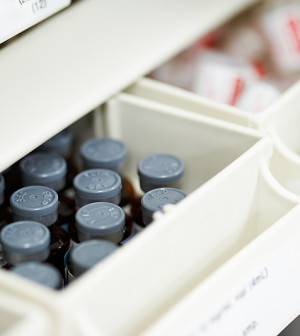- Skip Storing This Everyday Product in the Fridge Door
- Green Tea + B3 Pairing May Boost Brain Health
- Navigating Your Midlife Crisis: Embracing New Possibilities
- City Raccoons Showing Signs of Domestication
- Mapping the Exposome: Science Broadens Focus to Environmental Disease Triggers
- One Week Less on Social Media Linked to Better Mental Health
- Your Brain Changes in Stages as You Age, Study Finds
- Some Suicide Victims Show No Typical Warning Signs, Study Finds
- ByHeart Formula Faces Lawsuits After Babies Sickened With Botulism
- Switch to Vegan Diet Could Cut Your Greenhouse Gas Emissions in Half
FDA to Limit Use of Antibiotics in Farm Animals


WEDNESDAY, Dec. 11As experts continue to sound alarm bells about the rising resistance of microbes to antibiotics used by humans, the U.S. Food and Drug Administration on Wednesday announced it was curbing the use of the drugs in livestock nationwide.
“FDA is issuing a plan today, in collaboration with the animal health industry, to phase out the use of medically important [for treating human infections] antimicrobials in food animals for production purposes, such as to enhance growth rates and improve feeding efficiency,” Michael Taylor, deputy commissioner for foods and veterinary medicine at the agency, said during a Wednesday morning press briefing.
Experts have long stressed that the overuse of antibiotics by the meat and poultry industry gives dangerous germs such as Staphylococcus and C. difficile a prime breeding ground to develop mutations around drugs often used by humans. But for years, millions of doses of antibiotics have been added to the feed or water of cattle, poultry, hogs and other animals to produce fatter animals while using less feed.
To try and limit this overuse, the FDA is asking pharmaceutical companies that make antibiotics for the farming industry to change the labels on their products to limit the use of these drugs to medical purposes only.
At the same time, the agency will be phasing in broader oversight by veterinarians to insure that the antibiotics are used only to treat and prevent illness in animals and not to enhance growth, he said.
“What is voluntary is only the participation of animal pharmaceutical companies. Once these labeling changes have been made, these products will only be able to be used for therapeutic reasons with veterinary oversight,” Taylor explained.
“With these changes, there will be fewer approved uses [of these drugs] and remaining uses will be under tighter control,” Taylor said.
The most common antibiotics used in feed and also prescribed for humans affected by the new rule include tetracycline, penicillin and the macrolides, according to the FDA.
Two companies, Zoetis (Pfizer’s animal-drug subsidiary) and Elanco, have the largest share of the animal antibiotic market. Both have said they will sign on to the FDA’s program, Taylor said.
There was some initial praise for FDA’s move.
“We commend FDA for taking the first steps since 1977 to broadly reduce antibiotic overuse in livestock,” Laura Rogers, who directs the Pew Charitable Trusts’ human health and industrial farming campaign, said in a statement. “There is more work to do, but this is a promising start — especially after decades of inaction.”
Not everyone, however, saw the changes as a step forward in controlling the use of antibiotics in food production.
“FDA’s policy is an early holiday gift to industry. It is a hollow gesture that does little to tackle a widely recognized threat to human health,” Avinash Kar, the health attorney for the Natural Resources Defense Council, said in a statement.
“FDA has essentially followed a voluntary approach for more than 35 years, but use of these drugs to raise animals has increased,” he added. “There’s no reason why voluntary recommendations will make a difference now, especially when FDA’s policy covers only some of the many uses of antibiotics on animals that are not sick. FDA is failing the American people.”
But the FDA’s Taylor said a voluntary approach could be the fastest way to get results. He explained that any mandatory system would involve a complicated regulatory process that might tie progress up for years.
When an antibiotic becomes resistant to bacteria, it may not be as effective in treating infections and illness. Methicillin-resistant Staphylococcus aureus (MRSA) and resistant strains of C. difficile are two such germs that have spurred outbreaks — especially among weakened hospital patients — and generated alarming headlines over the past few years.
The FDA is asking companies to notify them of their intent to adopt the new guidelines over the next three months. The companies would then have three years to complete the labeling changes.
Once that happens, these antibiotics can no longer be used for animal production purposes, and their use to treat and prevent disease in animals will require the oversight of a veterinarian, the agency said.
But Keep Antibiotics Working, a coalition of health, consumer, agricultural, environmental, humane and other advocacy groups, also criticized the FDA for taking a voluntary approach rather than using its legal authority to prevent these drugs from being used in animals.
The group “is happy that the FDA has finalized this document so that we can see whether it actually works,” Steven Roach, a senior analyst for Keep Antibiotics Working, said in a statement. “Our fear, however, is that there will be no reduction in antibiotic use as companies will either ignore the plan altogether or simply switch from using antibiotics for routine growth promotion to using the same antibiotics for routine disease prevention,” he said.
More information
For more information on antibiotic resistance, visit the U.S. Centers for Disease Control and Prevention.
Source: HealthDay
Copyright © 2025 HealthDay. All rights reserved.










